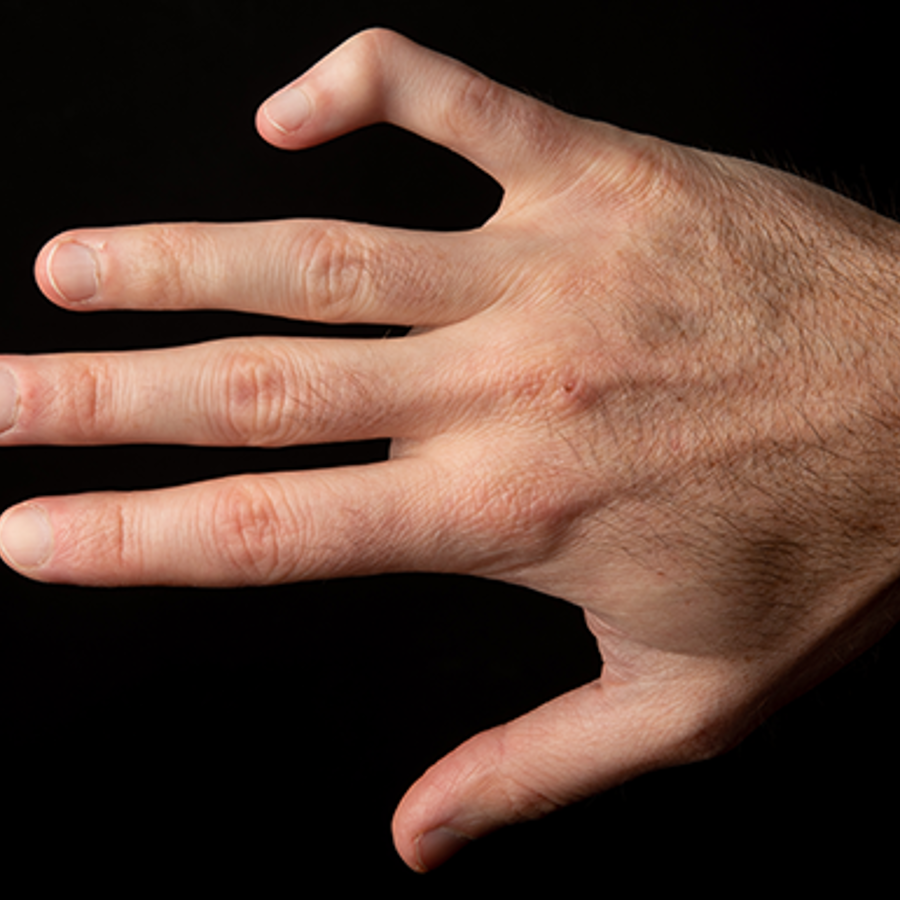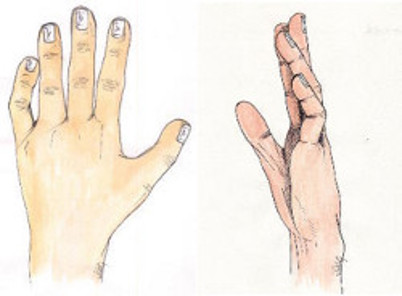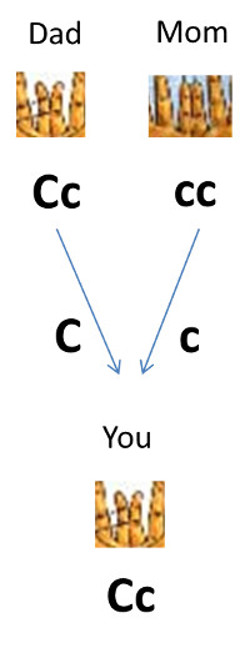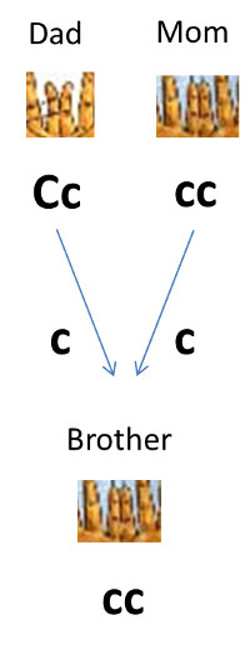
How can all my siblings but one have crooked pinkies if it’s a dominant trait?
May 30, 2013

- Related Topics:
- Dominant and recessive,
- Genetic myths
A middle school student from the U.S. asks:
"My dad has crooked pinkies. My mom does not. All of my brothers and sisters have crooked except for one of my brothers. Why is it that he doesn’t have crooked pinkies?"
If we go by what some of us learn in school, the answer is pretty easy. But then again, not everything we learn in school is the whole truth.
The real answer is that we don’t have an easy explanation for why this happened. Now don’t worry, this isn’t because it is impossible… It happens all the time. Lots of families match up with yours where one or a few members have straight pinkies and everyone else has crooked ones.
No, the real reason we can’t explain how your family ended up the way it did is that we don’t yet have a good handle on how pinky shape works. This is even though we are taught in school that it is a simple trait!

What I’ll do next is go over the school version. As you’ll see, even though it isn’t the way things necessarily work, it happens to work out in your case. In this explanation, your dad has a hidden straight pinky gene that by chance he only passed to your brother.
But even though the explanation works in your case, this isn’t because it is the right explanation. Like lots of other characteristics considered simple traits, things are much more complicated in the real world than they are in school.
Crooked Reality
In school we learn that we have two copies of most of our genes. This is true. So if there were a single “pinky shape” gene, we’d each have two copies of it.
The next idea is that genes can come in different versions. This is true too. In this case, we’d have a straight pinky version and a crooked pinky version.
To make things a little simpler, let’s call the crooked version C and the straight version c. You’ll see why I chose those letters in a moment.
So if there were a single pinky shaped gene, there’d be the following three possible combinations:
|
CC |
|
|
Cc |
|
|
cc |
|
Figuring out what someone’s pinkies look like with two of these combinations is easy. CC has only crooked pinky versions and so anyone with this combination would have crooked pinkies. And anyone with the cc combination would have straight pinkies because that is the only gene they have. But what about someone with the Cc combination?
Turns out they have crooked pinkies. This is because crooked (C) is dominant over straight (c). This is why I chose C for crooked and c for straight. The dominant version usually gets a capital letter and the recessive one a lower case letter.
So if you have one C and one c, crooked wins out and you have a crooked pinky. Here is what the table looks like filled in:
|
CC |
Crooked |
|
Cc |
Crooked |
|
cc |
Straight |
Now we can easily explain your family’s situation. All we have to say is that your dad is Cc and your mom is cc. He has crooked pinkies but carries a silent version of the straight pinky gene and your mom has two straight pinky copies.
Here is what happened for you and all your brothers and sisters with crooked pinkies:

In each case, your dad passed a C and your mom passed a c. All of you (except your brother with the straight pinkies) are Cc. You have crooked pinkies but carry a silent straight pinky copy from your mom.
Here is what happened in your brother’s case:

As you can see, both mom and dad passed a c and so he has the cc combination. He has only straight pinky gene copies and so has straight pinkies.
So there you have it, all tied up in a neat bow. Except that this isn’t really how things work. Pinky shape is a bit more complex than this.
Straight Talk
The idea of dominant and recessive traits is taught using a lot of different examples. Here is a partial listing of them:
|
Traits that are incorrectly taught as simple |
Taught as Dominant |
Taught as Recessive |
|
Tongue rolling |
Can roll tongue |
Can’t roll tongue |
|
Earlobe attachment |
Free earlobes |
Attached earlobes |
|
Pinky shape |
Bent (crooked) |
Straight |
|
Arm folding |
Dimple |
No dimple |
|
Cleft chin |
Cleft |
No cleft |
|
Hitchhiker thumb |
Straight |
Hooked |
|
Toe length |
2nd toe longer |
1st toe longer |
|
Widow’s peak |
Peak |
No peak |
None of these traits is as simple as shown in this table. Here they are shown to be caused by a single gene that comes in two versions with one version dominant over the other. These and lots more traits have been shown to be much more complicated than this. (Click here to see a fantastic website that presents the data that shows that these and many other traits are not as simple as advertised.)
Let’s focus on the pinky trait here. One of the big issues is that it is hard to define what is categorized as a straight pinky versus a crooked one. Turns out there is a wide range of bentness, making it hard to know where to draw the line at being bent. For example, should slightly bent fall into the straight or bent category? How about a little less or more bent than that?
The evidence for crooked pinkies being dominant is also not very strong. Only a few studies have been done with small groups and even then the results weren’t consistent.1 Crooked pinkies do not look to be dominant unless they are extremely crooked. And even this isn’t for sure.
This all may seem a bit silly to worry about, but it isn’t. Parents with supposedly recessive traits who have a child with a dominant one worry unnecessarily about this. I have even heard anecdotally of cases where a couple has gotten a divorce over this.
Teachers need to find new examples to teach these concepts (red hair and/or tasting PTC?) or even better, teach that nothing in genetics is so cut and dry. There are exceptions to even true dominant and recessive traits and people need to know this.
Read More:
- Khan Academy: A few reasons why traits aren’t always as simple as they seem
- National Human Genome Research Institute: A succinct definition of what makes a dominant allele dominant
- University of Delaware: A resource for traits that aren’t as simple as advertised

Author: Dr. D. Barry Starr
Barry served as The Tech Geneticist from 2002-2018. He founded Ask-a-Geneticist, answered thousands of questions submitted by people from all around the world, and oversaw and edited all articles published during his tenure. AAG is part of the Stanford at The Tech program, which brings Stanford scientists to The Tech to answer questions for this site, as well as to run science activities with visitors at The Tech Interactive in downtown San Jose.
 Skip Navigation
Skip Navigation
